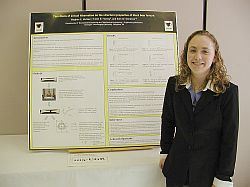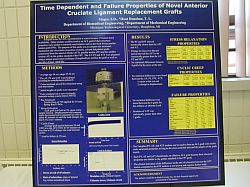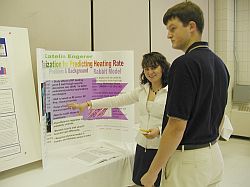
Previous Projects
2006-07
Projects
2005-06
Projects
2004-05
Projects
2003-04
Projects
Previous Projects |
Student
Projects 2004-2005 |
Undergraduate
Research Opportunities (UROP) |
Opportunities
exist for undergraduate engineering students to work on independent
research projects with Biomedical Engineering faculty. The opportunities
vary dependant on funding and projects that are available. Some opportunities
are listed below. Please contact the individual faculty member for more details about the project. If you don't see a project
that you are interested in, talk to the faculty member who most closely matches your interests. Projects may be available
that are not on this web page, or new projects may be initiated based
on student interest. |
|
1st Place Award
Undergraduate Research Presentation

|
Advisor(s)
Dr.
Seth Donahue
Assistant
Professor, Biomed Engineering
|
Student Researcher
Meghan McGee |
Project Title
The
effects of annual hibernation on the structural properties
of black bear femurs |
Sponsor
MTU
SURF Program,
Michigan
Space Grant Consortium |
Abstract
It
is known that bone strength is greatly reduced by disuse such
as prolonged time in space and extended periods of bed rest
due to injury, illness, and other causes. This condition
is known as disuse osteoporosis and is due to a lack of mechanical
stimulation to the tissue, which leads to increased bone resorption
and decreased bone formation. It takes a remobilization period
of approximately 2-3 times the length of the disuse period
to regain lost bone strength. This remobilization period is
not available for black bears, which experience annual disuse
by hibernating for 6 months of the year. It would be expected
that the cumulative deficit in regained bone each year would
contribute to a decline in bone strength with age in bears.
However, it has been shown that unlike other species, black
bears maintain normal bone formation during periods of disuse
(hibernation) and are able to elevate bone formation during
remobilization. Furthermore, though their disuse and remobilization
periods are approximately equal in length, their cortical
bone material properties do not decline with age. However,
changes in bone architecture may have a stronger effect on
whole bone strength than changes in material properties.
The purpose of this study was to determine if the structural
properties of black bear bones are negatively affected by
annual periods of disuse. We hypothesized that the mechanical
properties of black bear femurs would not decline with age
because bone formation does not decline during disuse and
is greatly elevated during remobilization. For this study,
14 black bear femurs were removed from hunter-killed bears.
Once cleaned of soft tissue, they were tested to failure in
three-point bending while force and displacement were recorded.
After fracture, the bones were reconstructed and histological
sections of the fracture were prepared. Segments of the bone
were also removed for later microstructural and compositional
analysis. The cross-sectional moment of inertia at the fracture
was determined using a custom-written macro. Ultimate stress
and energy to failure were calculated from the load-displacement
data and regressed against age (an indicator of annual disuse
periods). It was found that when males and females were considered
separately, ultimate stress did not change with age for males
or females. Energy to failure also did not change with age
for females, but significantly (p=.034) increased with age
for males. When males and females were grouped, ultimate
stress significantly (p=.023) increased with age whereas energy
to failure did not change with age. This is further evidence
that black bears possess a mechanism that helps them to avoid
the deleterious effects of disuse on bone strength. This
study is part of a larger project that may lead to the development
of therapies that help to combat disuse osteoporosis. |
|
2nd
Place Award Undergraduate Research Presentation

|
Advisor(s)
Dr.
Tammy Haut Donahue
Assistant
Professor, MEEM |
Student Researcher
Sarah Magee |
Project Title
Time
Dependent and Failure Properties of Novel Anterior Cruciate
Ligament Replacement Grafts |
Sponsor
Linvatec
Inc |
Abstract
2005
Summer Bioengineering Conference, June 22-26, Vail Cascade
Resort & Spa, Vail, Colorado Clinical Relevance: If the
surgeon chooses to use an allograft to reconstruct a torn
anterior cruciate ligament (ACL), then the Tutoplast® patellar
(PT), achilles (AT) or folded anterior tibialis (ATT) tendons
can be expected to provide structural properties similar to
or better than the fresh frozen non-irradiated patellar tendon
(FPT) graft. Introduction: Allograft tissue for ACL reconstruction
is scarce because of limited donor availability. Other tendons
could be used as an ACL graft if their structural properties
were similar to currently used tendons such as the FPT graft.
The purpose of this study was to compare the structural, mechanical,
and viscoelastic properties of sterile, solvent dehydrated
AT, PT and ATT grafts to the gold standard of the fresh frozen
patellar tendon grafts. The AT, PT and ATT were prepared using
a unique preservation technique to sterilize the graft as
well as provide a longer ’shelf-life’. Methods and Materials:
All grafts were harvested from middle-aged donors (average
age = 54 yrs, range 25-76 yrs). The AT, PT and ATT samples
were hydrated according to the manufacturer’s protocol (Tutogen
Medical Corp.) and FPT samples were thawed at room temperature
prior to testing. ATT samples were folded in half to form
the graft. FPT samples were bisected longitudinally using
an oscillating bone saw to form grafts. The cross-sectional
area and length of each graft was measured. Tests were conducted
on a servo-hydraulic uniaxial test machine (Instron Corp,
Model 8872). Each graft was mounted in previously described
grips [1-3]. ATT testing was performed by looping the middle
of the tendon over a bar at the base of the materials testing
machine and gripping the two free ends with a freeze clamp.
PT and FPT testing proceeded by potting each bone block end
into tensile fixtures. AT testing included potting the bone
block into a tensile fixture while holding the other end with
a freeze clamp. Grafts were pre-tensioned at an initial load
of 75 N for 5-10 minutes under displacement control in series
with an extension coil spring, which simulated the stiffness
and travel of the Linvatec graft-tensioning device used intra-operatively
(spring rate of 35 lb/in). To characterize the viscoelastic
properties, each graft was preconditioned for 10 cycles at
0.1 Hz between 0 and 3% strain. The 11th cycle was held at
3% strain while the sample relaxed. This displacement was
held constant while the decreasing load was measured at 4
Hz until the load changed less than 0.1 percent over 1 minute.
After a sufficient time for recovery, as determined in preliminary
testing (24 hours), the grafts were cycled between 20 and
100 N at a rate of 0.33 Hz until less than a 0.1% change in
displacement was seen with consecutive cycles. This loading
represented intra-operative in vivo preconditioning of the
graft prior to tibial fixation. To characterize the failure
properties, load-to-failure tests were performed following
the creep test after full recovery of the graft (24 hrs).
Each graft was preconditioned as described above and then
pulled to failure at a strain rate of 2 percent/s [1,2]. Structural
and mechanical properties were determined for each graft and
compared using ANOVA. Results: The PT relaxed statistically
slower than the ATT and AT, while the change in stress over
the test period showed the ATT to be statistically greater
than the 3 remaining grafts. Finally, there were no statistical
differences between the 4 grafts for the stress at the end
of time dependent and failure properties of novel anterior
cruciate ligament replacement grafts. |

|
Advisor(s) |
Dr.
David Nelson
Professor,
Biomed Engineering |
Student Researcher
Katelin Engerer |
Project Title
Tissue
Characterization and Identification for Predicting Frequency
Energy Deposition Rates |
Sponsor
MTU
SURF Program |
Abstract
Models
of Human exposure to electromagnetic energy of radio frequency
(RF) are usually based on calculation of energy absorption
per unit mass (the 'specific absorption rate' or SAR). Standards
for safe exposure to RF are based on the SAR, and not on temperature.
As the known bio-effects of RF exposure is heating, it would
be useful to have model which predicts temperature increase
resulting from exposure. The ability to predict tissue
temperature increases requires development of a detailed database
of tissue properties (thermal and electric). The objective
of the current study was two-fold: 1) Incorporate physiological
feedback in a working thermal model of human whole-body RF
exposure. This model, “ThermoReg,” uses a database derived
from the National Library of Medicine’s “Visible Man” model.
It does not, however, include several tissues which are significant
in determining human response to radiation absorption. Specifically
it does not include the hypothalamus, nor does it distinguish
between skeletal and smooth muscle. 2) Develop a detailed
model of the skin anatomy. This is especially important for
simulating thermal effects of high-frequency exposure (GHz
range and higher), where RF energy penetration is shallow
and differences in skin composition may effect heating significantly.
Results from the addition of the new tissue types show incorporation
of hypothalamic feedback enables simulation of thermoregulatory
responses to environmental heating. The skin model is based
on a histological study of the skin in the ear of the domestic
rabbit, which is an accepted thermoregulatory model of the
human skin. Identification of the corresponding electrical
and thermal properties is in progress. |
|
|
|
|

